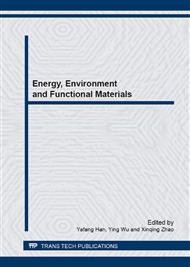p.41
p.46
p.52
p.58
p.65
p.71
p.76
p.82
p.92
Effects of Different Acids and pH on the Degradation of Sodium Dodecyl Benzene Sulfonate by TiO2-Bentonite
Abstract:
Five types of TiO2-bentonite catalyst, #1, #2, #3, #4, and #5, were prepared separately using hydrochloric acid, nitric acid and perchloric acid by the sol-gel method. The original concentration of sodium dodecyl benzene sulfonate (SDBS) in the aqueous solutions was 20 mg/L. The amounts of SDBS degraded by #1, #2, #3, #4 and #5 under a 6 W ultraviolet lamp were compared, the influences of #1 and #2 on the chemical oxygen demand (COD) of the aqueous solutions studied. And the influences of the initial pH on the degradation of SDBS and on the COD of aqueous solutions were investigated. The results showed as the following. (1) When the catalyst input was 0.5‰ and the solutions were irradiated with a 6 W ultraviolet lamp, 81.0%, 90.5% 47.5%, 39.5% and 26.5% of the SDBS in the aqueous solutions was degraded within 2 hours by catalysts #1, #2, #3, #4 and #5, respectively. The COD was reduced by 8.81% and 50.84%by catalysts #1 and #2, respectively. (2) Under an ultraviolet lamp, 94.5% and 99.3% of the SDBS in the aqueous solutions was degraded and 33.59% and 96.93% of the COD was reduced within 6 hours by catalysts #1 and #2, respectively. TiO2-bentonite catalyst #2 was the best based on the effects on the degradation of SDBS and on the reduction of the COD of aqueous solutions. Using nitric acid was better than using hydrochloric acid or perchloric acid for the preparation of TiO2-bentonite. (3) Under the same conditions (20 mg/L SDBS, 20°C, ultraviolet light irradiation time of 2 h, electromagnetic mixing, 0.5‰ input of TiO2-bentonite #2 ), 90.3% and 90.5% of SDBS was degraded by TiO2-bentonite #2 at pHs 6 and 8, respectively. The optimal pH range for SDBS degradation was 6~8. The COD was reduced by 59.5% and 63.5% pHs 4 and 6, respectively. The optimal pH range for the COD reduction was 4 ~ 6. The pH had a clear effect on SDBS degradation and the COD of the aqueous solutions.
Info:
Periodical:
Pages:
65-70
Citation:
Online since:
April 2014
Authors:
Price:
Сopyright:
© 2014 Trans Tech Publications Ltd. All Rights Reserved
Share:
Citation:


